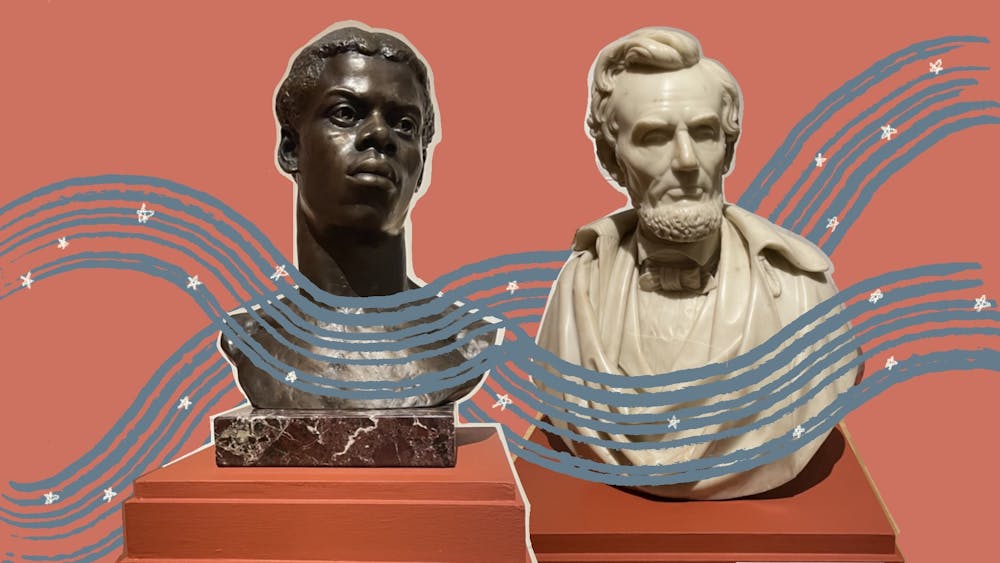As I turn the corner into the main exhibition hall at The Pennsylvania Academy of Fine Arts, I see a painting I’ve seen a million times before—the stately, perhaps boring, Washington at Princeton (1779) by Charles Willson Peale. George Washington rests his hand on a cannon, standing confidently after winning the titular battle. The flag of the thirteen colonies waves in the background—just above his enslaved valet, William Lee.

Charles Willson Peale, (1741 1827) George Washington at Princeton, 1779. Oil on canvas, 93 x 58 1/2 in.
Gift of Maria McKean Allen and Phebe Warren Downes through the bequest of their mother, Elizabeth Wharton McKean, 1943.16.2. Photo courtesy of PAFA.
Next to this portrait sits another one that is both eerily similar and drastically different. James Brantley’s self–portrait Brother James (1968) features him, a Black man, wrapped in a soiled American flag after returning home to Philadelphia from military service in Vietnam. He stands with his hand on his heart and is highlighted with the same confidence Washington possesses.

James Brantley, (b. 1945). Brother James, 1968. Oil on canvas, 60 7/16 x 40 1/4 in. John Lambert Fund, 1970.1. Photo courtesy of PAFA.
The juxtaposition of these paintings forces the viewer to ponder what it means to be an American during wartime—and what it means to be depicted in American art. Although Washington is framed by horses, soldiers, and weapons, he is highlighted with the same importance and distinction as Brantley—who is surrounded by only red and his American flag.
The show Making American Artists: Stories from the Pennsylvania Academy of the Fine Arts, 1776-1976, tells the story of American art over two centuries. The exhibition starts in 1776 with the founding of our nation and continues to 1976, the date of the restoration of PAFA’s facilities and the end of the second American century. The works are split into five categories—portraiture, history, still life, genre scenes, and landscape—separated by genre, not by chronology, to allow the viewers to make connections across time and place. Every artist in the exhibition has a connection to PAFA; they all either trained or were exhibited there, solidifying Philadelphia’s place in the American art canon.
Continuing through the exhibition, I run into more of these obvious comparisons. Gilbert Stuart’s George Washington (Landsdowne Portrait) (1796), depicting the first President standing at his desk, is strategically placed next to John Neagle’s Pat Lyon at the Forge (1829). America’s first president—who is dressed impeccably—is analyzed alongside Pat Lyon, a blacksmith with his sleeves rolled up and an apron on, who was previously falsely imprisoned for a bank robbery. Despite the men’s differences in role and class, they both proudly stand at their workspaces.
Further into the exhibit stands the bust Slave Boy (1899) by May Howard Jackson, the first Black woman to attend PAFA. This dark bronze bust sits next to Randolph Roger’s white marble bust Abraham Lincoln (1866). Another obvious, but telling comparison is at play.
Female artists heavily contribute to this exhibition as well, and the exhibit explores their roles in American art history. Most of these women's art depicts domestic scenes—children's play or motherhood—as that was the sphere to which they were confined. Elizabeth Okie Paxton’s Sick a–Bed (1916) shows a young woman ill in bed. This work was painted before Paxton’s switch to still life to avoid competing with her portrait–painting husband. According to PAFA, this was "a strategy many women artists employed by necessity.” The ultra–famous Mary Cassatt and Georgia O’Keefe are also featured in the exhibit with very characteristic paintings of a mother and child and a floral still life.

Mary Cassatt, (1844 - 1926), Baby on Mother's Arm, ca. 1891. Oil on canvas, 25 x 19 3/4 in. Bequest of Peter Borie, 2003.15. Photo courtesy of PAFA.
The experiences of LGBTQ artists are also featured. Harriet Hosmer’s Puck on a Toadstool (1856) serves as an allegorical self–portrait, as she was (according to PAFA) often described as “willful,” “like a little boy,” and “queer,” similar to Shakespeare’s Puck. Hosmer was one of the most famous female American artists of the 1800s, and lived with a group of women in Rome who were known for their androgynous fashion, independence, and lesbian relationships.
While PAFA is known for its vast, influential collection of American art, this exhibit shines a new light on its most notable collections. Making American Artists features art that touches on all aspects of the national experience, highlighting artists from groups who have been previously excluded from the American art historical canon.

Georgia O'Keeffe, (1887-1986) Red Canna, 1923. Oil on canvas, 12 x 9 7/8 in. The Vivian O. and Meyer P. Potamkin Collection, Bequest of Vivian O. Potamkin, 2003.1.8. Photo courtesy of PAFA.
By exhibiting these works alongside each other, we are invited by the curators to view American art across time, race, gender, sexual orientation, and class. We are invited to more deeply understand who and what makes American art—and subsequently who and what makes American culture, history, and tradition.
There are countless unrecognized and remarkable people—women, LGBTQ people, and people of color—whose influence on our shared cultural consciousness goes unacknowledged. So let us honor their work.







